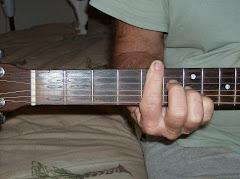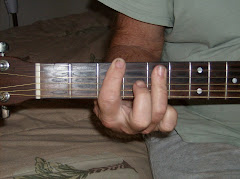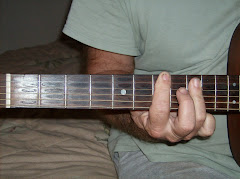I used to play left handed guitar quite a bit with other musicians. Though I have always played a right handed guitar that I flipped over, the other musicians never had a problem comprehending what I was doing once they got used to watching me play.
I played a lot of bluegrass music when I was younger so that meant playing several jam sessions with various instruments. I even played rhythm to a penny whistle once.
Musicians notice immediately that I am playing a right handed guitar left handed and are usually amused at watching me play left handed. It is sort of a novelty, but once they catch on, I am told that the chords that I am making actually look similar to right handed chords.
I don't play with other musicians anymore but probably will again in the future. I record my own music and send it out over the Internet. Everything I do now days is overdubbed. I play all of the instruments on my songs. I also play left handed bass guitar and left handed mandolin. They are right handed instruments, and I play them upside down just like I do the guitar.
I didn't need a left handed guitar teacher to learn how to play. What ever I didn't pick up on my own, I learned from right handed players. It's not that hard to interpret what someone else is playing and I never considered it anymore difficult than a right handed guitar player learning to play. People think that it's a handicap and it's not.
Here is the point. If you are considering learning to play a right handed guitar left handed upside down, don't be intimidated because it's not that hard to do. The chords are easier to make for me, but you may have to concentrate on an upstroke with your left hand when playing rhythm guitar with other musicians. Some people will enjoy having you in their band because of the novelty. Audiences notice this and are amazed. If you can play some good lead licks, they are that much more amazed and will tell their friends.
Saturday, August 23, 2008
Playing Left Handed With Other Musicians
Posted by
Ben Willis
at
12:15 PM
3
comments
![]()
![]()
Labels: guitar, left handed, left handed guitar, Music, right handed, right handed guitar
Monday, August 11, 2008
Left Handed Guitar Player Playing Right Handed Guitar
I've read some articles recently on the Internet that explain how to convert a right handed guitar into a left handed guitar. They explain the problems that you would have with the nut, bridge, and saddle. This is all fine and dandy if you are converting an electric solid body guitar, but it is a gamble with a hollow body electric and/or acoustic. I covered this in my article Should I Play A Right Handed Guitar Left Handed? You can try it if you want, but I would use a very cheap guitar to try it on.
Like I said in the article, I asked a Luthier from a very well established guitar manufacturer who explained that when converting to a left handed guitar, "The bracing, bridges, and tone bar are set up for right handed players". The bracing and tone bar are inside of the guitar. When a string is tuned, it adds tension to the guitar. Each string adds a different degree of tension and the bracing and tone bar are in a position to compensate for the different degrees of tension. When the strings are reversed, the degrees and position of tension are changed, hence his quote, "The bracing, bridges and tone bar are set up for right handed players". It could cause cracking or warping of the internal parts. The bracing and tone bar add structural reinforcement to the guitar.
I had a cheap $20 guitar when I was a kid and I switched the strings around to play left handed and didn't notice any adverse affects, but I could barely tune it at that time much less know if I broke something.
The point is that if you are left handed playing a right handed guitar, it is better to be safe than sorry. Either learn how to play it right handed or learn how to flip it over and play upside down, especially if it is an expensive acoustic.
Posted by
Ben Willis
at
11:08 AM
0
comments
![]()
![]()
Labels: guitar, left handed, left handed guitar, Music, right handed, right handed guitar
Ben Willis demonstrating the "left handed upside down guitar method".

A chord


B Chord


C Chord


D Chord


E Chord


F Chord


G Chord


B Barre Chord


D Barre Chord

Contact Info
bwillismusic@gmail.com
Links To Other Sites
- Accordion Music
- Bass Clarinet
- Ben Willis Soundclick Page
- Celtic folk by Kevin Edward Rose
- Custom Made Left Handed Guitars
- Esteban Guitar Lessons
- Guitar Blog
- Guitar Lessons At infinateguitar.com
- Guitar Repair Bench/ A site dedicated to providing the best instructional articles about guitar repair, maintenance, and guitar building on the web, so you can repair your own guitars.
- Guitar Tab College
- Guitar Tabs
- Guitar Tabs
- Guitar Tips
- Guitarwar.com
- How To Play The Violin
- Learn How To Play Guitar Online
- Learn To Play Guitar
- Left Handed Guitars At Affordable Prices
- Lefty Guitar Trader: Guitar Forum
- LeftyFretz/ Devoted To The Left Handed Guitar Player
- Metronome
- Piano Lessons
- Rock Guitar Lessons/ Best Electric Guitar Lessons
- Single Of The Day
- Sound Tempest
- The Beatles Lyrics
- The Fifth Wheel
- The Left Handed Page
- The Left Handed Site
- The Musicians Forum/ Helping Musicians Turn Into Masters/ Free Lessons
- Upside Down Guitar On Facebook
- Used Ibenez
- Yamaha Keyboards & Guitars
- You Rock Collection





